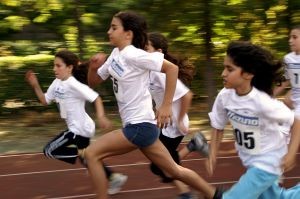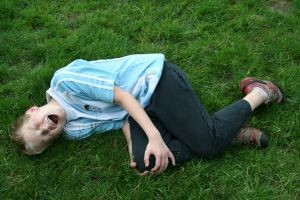By Jeff King, MA, CSCS
In my previous article, “Training Kids for Sports – Part 1: The Importance of Free PlayI” I discussed the importance of working on the fundamentals of human movement with young athletes. I stressed the benefit of improving fundamental movement skills and how it can improve athletic performance.
Another important key benefit of optimizing human movement is how it can greatly reduce the risk of injury. When I consult with parents regarding their child’s training, I actually mention injury prevention as being the most important part of our training program.
You can make any athlete bigger, faster, and stronger; but if he develops an injury, then his strength and speed gains are useless. Here are some ways that proper training can help prevent injury:
- Increasing work capacity: General Physical Preparation (GPP)
 Many sports injuries occur when an athlete is in a fatigued state. Decision-making slows and the reactive ability to certain motor tasks is compromised, making the athlete susceptible to injury. Therefore, better conditioning results in lower risk of injury.
Many sports injuries occur when an athlete is in a fatigued state. Decision-making slows and the reactive ability to certain motor tasks is compromised, making the athlete susceptible to injury. Therefore, better conditioning results in lower risk of injury.
The best way to ensure this is by focusing the workout on General Physical Preparation (GPP). GPP in essence is a phase of training where the main objective is to improve and increase work capacity. Building an aerobic and anaerobic base will allow an athlete to increase her conditioning thus leading to a better, more injury resistant athlete.
- Proper stability through movement
 Joint stability is a critical component of injury prevention. Knee injuries are an all too common example of what can go wrong without proper stability. Many ACL injuries occur in part due to instability in the knee. When an athlete changes direction, it involves planting then cutting. Oftentimes when an athlete attempts to cut after planting, the lack of stability in their knee causes him to cut inefficiently leading to injury. It’s imperative that athletes develop joint stability to ensure proper execution of movement. Efficient movement can greatly reduce the risk of injury.
Joint stability is a critical component of injury prevention. Knee injuries are an all too common example of what can go wrong without proper stability. Many ACL injuries occur in part due to instability in the knee. When an athlete changes direction, it involves planting then cutting. Oftentimes when an athlete attempts to cut after planting, the lack of stability in their knee causes him to cut inefficiently leading to injury. It’s imperative that athletes develop joint stability to ensure proper execution of movement. Efficient movement can greatly reduce the risk of injury.
- Address muscle imbalances/asymmetries
Injuries often occur because an athlete displays muscle imbalances and asymmetries. With imbalance and asymmetry the athlete will have a tendency to compensate in order to execute a movement. The compensation, over time, will lead to certain muscles being over developed and over utilized and other muscles to be under developed and under utilized.
These imbalances can lead to both acute and chronic injuries. The development of a proper training program with a systematic approach for young athletes can assure their body is well balanced and their asymmetries are minimal.
In the final part of this three part series, I will discuss the five key movement patterns a young athlete should perfect in order to improve sports performance.
About Jeff King
Jeff King, MA, CSCS has been a strength and conditioning coach since 2005 and is currently the Director of Athletics at Fitness Quest 10 located in San Diego, CA. Jeff is the co-author of Pigskin Prep: the definitive youth football training program and the ultimate guide to injury prevention, speed development and strength training for the “14 and under” youth football athlete. For more information please visit www.youthpigskinprep.com.
Craig Valency, MA, CSCS, president and co-founder of SPIDERfit, has been a personal trainer for the last 11 years. He is currently working at Fitness Quest 10 in San Diego, an elite personal training and athletic conditioning facility. He specializes in youth strength and conditioning programs that promote physical literacy, injury prevention and optimal performance. Along with training youths from 6 to 18 years of age for general fitness, Craig has also worked with some of the top junior tennis players in the world. He has been a physical education consultant for the Stevens Point school district in Wisconsin for the last 3 years, helping revamp the district wide programming for the K-12 PE curriculum. Craig earned his bachelor degree from UCLA, and Masters Degree in Kinesiology from San Diego State University.





Connect with SPIDERfit!